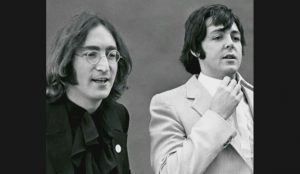9 Musicians That Had Success Going Solo

via strangedaysindeed9 / YouTube
Throughout the history of rock music, we’ve witnessed some incredible stories of stars who took a bold step away from their bands to embark on solo careers, and their journeys have been nothing short of remarkable.
As it turns out, not every moment in the spotlight was meant to be shared. Perhaps driven by artistic necessity, internal band conflicts, or a desire for greater financial rewards, some artists feel compelled to step out from their group roles and take center stage as solo performers.
In some instances, these separations are marked by bitterness and conflict, while in others, the solo career and group activities continue side by side. However, there are certain artists who manage to seize the spotlight with such audacity that their solo moments rival, and at times even surpass, the success of the groups they originally emerged from.
Let’s just forget about the Dee Dee Ramoneses and Daryl Halls for a bit and take inspiration from these artists who dared to strike out on their own and successfully shaped their own legends.
1. Billy Joel
The Piano Man’s musical journey began with his band The Hassles in the mid-1960s. As a young and aspiring musician, he joined the band as their keyboardist and vocalist.
While The Hassles released a couple of albums, including The Hassles (1967) and Hour of the Wolf (1969), their success was relatively modest and didn’t propel them into the musical stratosphere. However, this period was instrumental in honing Joel’s skills as a performer and songwriter.
Celebrate 40 years of An Innocent Man on @applemusic! https://t.co/EvszYPflGM pic.twitter.com/MQR5F9APa6
— Billy Joel (@billyjoel) August 9, 2023
It was in the early 1970s that Billy Joel made the pivotal decision to pursue a solo career. The transition from being a member of a band to a solo artist can be a daunting one, but Joel’s undeniable talent and dedication to his craft set the stage for his remarkable solo success. His first solo album, Cold Spring Harbor, was released in 1971, and though it faced initial technical issues that affected the sound quality, it showcased his songwriting prowess.
Despite the challenges, Billy Joel persevered, and his breakthrough came with the release of Piano Man in 1973. The title track, “Piano Man,” became an instant classic and is still one of his most beloved songs.
2. John Denver
In the early 1960s, a young John Denver joined the Chad Mitchell Trio, a popular folk group known for their harmonious melodies and socially conscious lyrics. As a member of the trio, Denver contributed his distinctive voice and songwriting skills, which were already beginning to shine.
During his time with the group, Denver made a significant impact on the folk music scene. His songwriting abilities were evident in tracks like “Leaving on a Jet Plane,” which would later become a massive hit for Peter, Paul and Mary.
View this post on Instagram
However, it was in the early 1970s that the budding folk icon made the transition to a solo career that would define his legacy. Denver’s hard work paid off when his fourth album, Poems, Prayers & Promises, became a hit.
This 1971 record featured the iconic hit “Take Me Home, Country Roads”, the song catapulted Denver to stardom and became an anthem for generations.
3. Smokey Robinson
Smokey Robinson, born William Robinson Jr. in 1940, was a gifted singer and songwriter from a young age. He co-founded The Miracles in the mid-1950s with childhood friends, and they soon became a prominent act in the Detroit music scene. Under Smokey’s leadership, The Miracles signed with Berry Gordy Jr.’s Motown Records in the late 1950s, marking the beginning of their legendary career.
As the principal songwriter for The Miracles, Robinson penned some of the most iconic songs in the Motown catalog. Hits like “Shop Around” (1960) and “You’ve Really Got a Hold on Me” (1962) not only showcased his lyrical prowess but also his soulful and smooth vocal delivery. The Miracles’ harmonious sound, combined with Smokey’s distinct falsetto, set them apart and made them a beloved group of the Motown era.
1981. #ThrowbackThursday pic.twitter.com/sf6vLhVAAS
— Smokey Robinson (@smokeyrobinson) April 22, 2021
After retiring for a year, Smokey Robinson embarked on a solo career in the early 1970s. His transition to a solo artist was marked by the release of the album Smokey in 1973, which included the chart-topping single “Baby Come Close”.
Robinson’s solo work continued to capture the hearts of audiences until he finally hit the sweet spot of solo success with 1975’s A Quiet Storm and 1979’s Where There’s Smoke…, which produced the Billboard Top Ten pop hit single “Cruisin'”.
4. Neil Young
Neil Young was already a talented musician before he found critical success with folk and country rock progenitors, Buffalo Springfield. He bounced around bands, toured solo, and even joined a band fronted by Rick James before moving to LA with bandmate Bruce Palmer.
Young and Palmer would go on to form Buffalo Springfield with Stephen Stills, Richie Furay, and Dewey Martin in 1966. The band quickly gained recognition for their unique blend of folk and rock, with Young’s distinctive songwriting playing a pivotal role.
View this post on Instagram
Palmer’s deportation due to marijuana use, compounded by the strain between the band members, prompted Young to leave and go back to going solo. In 1969, Neil Young released his self-titled to mixed reviews, though it did bring the spotlight to his talent as a prolific songwriter.
Young’s second solo album, Everybody Knows This Is Nowhere (1969), marked the formation of his backing band, Crazy Horse, which would accompany him to superstardom. The album featured the timeless classics “Cinnamon Girl”, “Cowgirl in the Sand”, and “Down by the River” – three hits in bed on the same day while nursing a high fever.
5. Phil Collins
The influential progressive rock drummer Phil Collins was more than just the man behind the kit of Genesis and much more than the singer behind schmaltzy “Against All Odds” and the Tarzan soundtrack.
Collins joined neo-progressive rock band Genesis in 1970 as the band’s drummer and backup vocalist. Little did he know that his role within Genesis would become an essential chapter in the band’s history and lay the foundation for his own solo stardom.
as the ’70s progressed, the band’s music evolved, with Phil taking on lead vocal duties after original frontman Peter Gabriel to also forge his own solo success. The former’s distinctive voice and charismatic stage presence began to shine through, and his songwriting contributions, including hits like “Follow You Follow Me” added a pop sensibility to the band’s repertoire.
View this post on Instagram
While continuing his Genesis work, in 1976, Phil Collins released his first solo album, Face Value. The album included the iconic single “In the Air Tonight”, which showcased his soulful voice and emotionally charged lyrics. The song’s haunting drum solo became instantly recognizable and catapulted him into the spotlight as a solo artist.
But it was his sentimental movie soundtrack hit “Against All Odds” that made Collins a household name worldwide. He continued releasing successful singles and albums throughout the 80s and 90s as a solo artist, and in 1996 he formally left Genesis.
6. Ozzy Osbourne
Chances are high that when you scream out “all aboooooooard”, someone from somewhere will echo “aye aye aye” in response. That’s the effect of “Crazy Train”, folks, and that’s how popular Ozzy Osbourne became when he jumpstarted a solo career that would eclipse the success of his former band Black Sabbath.
The heavy metal pioneers quickly climbed the ranks and established a hefty influence in rock, with Ozzy’s distinctive, haunting vocals leading the charge. Hits like “Paranoid” and “Iron Man” solidified the band’s status as one of the most influential and successful rock acts of all time. However, internal conflicts and substance abuse issues led to Ozzy’s departure from Black Sabbath in 1979.
View this post on Instagram
Embracing a new beginning as a solo artist, Ozzy released his debut album, Blizzard of Ozz, in 1980. The album featured guitar virtuoso Randy Rhoads and showcased a more melodic and accessible side of The Princes of Darkness’ music. “Crazy Train” became an instant classic and marked the beginning of his solo journey with a bang.
Throughout the 1980s, Ozzy continued to release successful albums, including Diary of a Madman and Bark at the Moon. His energetic live performances and unique stage persona, often characterized by his signature bat-biting antics, cemented his reputation as one of rock’s most captivating frontmen.
7. Paul McCartney
Being a prominent member of the world’s greatest band certainly helped, but Paul McCartney should take a lot of credit for his courage in facing the world again after the breakup of The Beatles. After being encouraged by his then-wife Linda, Macca climbed from his post-breakup depression and crafted “Maybe I’m Amazed”, a classic hit from his debut solo McCartney.
In the early 1960s, the Fab Four took the world by storm with their innovative sound and infectious melodies. McCartney, along with John Lennon, George Harrison, and Ringo Starr, created a musical revolution that forever changed the landscape of popular music. Hits like “Yesterday”, “Let It Be”, and “Hey Jude” not only topped the charts but also became timeless classics that continue to resonate with audiences today.
View this post on Instagram
After The Beatles disbanded in 1970, Paul released “McCartney,” released in 1970, which showcased his versatility as a singer-songwriter and multi-instrumentalist and established a solid solo career.
On top of his independent endeavor, Paul also formed the band Wings in 1971, which included his wife Linda McCartney. With Wings, he released a series of successful albums, including Band on the Run (1973), which featured hits like the title track and “Jet”.
Throughout his solo career, McCartney has received numerous accolades, including Grammy Awards, and has been knighted by Queen Elizabeth II for his services to music. His enduring influence on the music industry is immeasurable, and his live performances continue to draw crowds of all ages.
8. Stevie Nicks
The story of Stevie Nicks is a captivating tale of a remarkable career that unfolded both as a member of the legendary band Fleetwood Mac and as a successful solo artist. Born in 1948, Stevie Nicks joined Fleetwood Mac in 1975, alongside her then-partner Lindsey Buckingham, and it marked a turning point not only for the band but also for her own musical journey.
Fleetwood Mac’s album Rumours, released in 1977, became a monumental success, catapulting the band to global stardom. Stevie’s distinctive voice and her heartfelt songwriting played an integral role in the album’s success. Hits like “Dreams” and “Go Your Own Way” became anthems of the era, and Stevie’s ethereal stage presence added a layer of enchantment to the band’s live performances.
View this post on Instagram
Despite Fleetwood Mac’s immense popularity, Stevie Nicks decided to explore her solo potential in 1981. Her debut solo album, Bella Donna, was a triumph. It featured iconic tracks like “Edge of Seventeen” and “Leather and Lace”, which were moving exhibitions of her versatility as an artist and songwriter. Stevie’s solo work complemented her contributions to Fleetwood Mac, and she seamlessly balanced both aspects of her career.
In the years that followed, Stevie Nicks released a string of successful solo albums, including The Wild Heart (1983) and Rock a Little (1985). Songs like “Stand Back” and “Rooms on Fire” became radio staples, and her solo career continued to flourish, fortifying her status as an independent force in the music industry.
9. Michael Jackson
MJ definitely had the most decorated career in this list of risk-takers who created their own fabled undertakings by going solo. Not including his name due to his controversial personal life is an insult to the monumental contributions he bestowed upon pop music and culture.
Michael Jackson’s ascent from the youthful frontman of the Jackson 5 to becoming the King of Pop in his solo career is nothing short of legendary. Born in 1958 in Gary, Indiana, Michael showed his exceptional talent at a tender age as the lead singer of the family group, the Jackson 5.
The Jackson 5 burst onto the music scene in the late 1960s, and Michael, with his mesmerizing vocals and undeniable stage presence, was an instant standout. Hits like “I Want You Back” and “ABC” showcased the group’s youthful exuberance and Michael’s incredible vocal range. The Jackson 5’s success was meteoric, and they became a sensation in their own right.
View this post on Instagram
During The Jackson 5’s heyday, it wasn’t unusual for members to explore solo endeavors. In 1972, both Michael and Jermaine embarked on solo careers, but it was in 1979 that we truly witnessed the emergence of the Michael Jackson who would go on to dominate the ’80s and ’90s.
This transformation was marked by the release of the disco-infused album “Off the Wall,” which followed his appearance in the sensational movie musical “The Wiz” just a year prior.
The ’80s saw the release of Thriller, an album that would become the best-selling album of all time. It included iconic tracks like “Billie Jean”, “Beat It”, and the title track “Thriller”, Michael’s groundbreaking music videos, including the iconic “Thriller” video, redefined the medium and made him a global superstar.




















